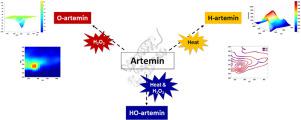Journal of Photochemistry and Photobiology B: Biology ( IF 5.4 ) Pub Date : 2020-09-03 , DOI: 10.1016/j.jphotobiol.2020.112013 Zeinab Takalloo 1 , Mohammad Javad Masroor 2 , Ahmad Mani-Varnosfaderani 2 , Bahman Maroufi 3 , Reza H Sajedi 1

|
Artemin is a potent molecular chaperone, which protects Artemia embryos undergoing encystment against extreme environmental stresses. In the present work, we have examined the structural changes of artemin from A. urmiana upon exposure to oxidant and heat, by using CD measurements as well as excitation-emission fluorescence spectroscopy as a powerful tool for monitoring the conformational transitions and molecular interactions in proteins. We have also provided here the first document on reporting the three dimensional fluorescence spectra of a protein using ANS. Totally, the fluorescence results indicated that the microenvironments of tyrosine and tryptophan residues and the hydrophobic pockets as well as the polypeptide backbone or secondary structure of the chaperone were influenced in responses to heat and H2O2 in different degrees. Moreover, the native state of artemin did not induce a considerable exposure of the internal non-polar groups to the solvent. Besides, the excitation-emission spectra of heated artemin by ANS revealed new emission peaks at 430–450 nm when it was excited at 330 nm, which suggests probable exposure of new binding sites for hydrophobic or electrostatic interactions of the protein with ANS. The protein also showed a greater conformational sensitivity to the temperature fluctuations compared to oxidation. Here, we presented some evidence in support of the relation between artemin and its stress dependent activation in vitro and in vivo. This study can expect that the EEM fluorescence spectroscopy could provide a promising tool to study conformational transitions of proteins.
中文翻译:

通过激发-发射荧光光谱探测热和氧化诱导的分子伴侣蛋白的构象变化。
Artemin是一种有效的分子伴侣,可保护遭受包囊作用的Artemia胚胎免受极端环境压力的影响。在目前的工作中,我们检查了来自A. urmiana的artemin的结构变化在暴露于氧化剂和热的情况下,通过使用CD测量以及激发发射荧光光谱作为监测蛋白质中构象转变和分子相互作用的有力工具。我们在这里还提供了有关使用ANS报告蛋白质三维荧光光谱的第一份文件。总的来说,荧光结果表明酪氨酸和色氨酸残基的微环境以及疏水口袋以及伴侣分子的多肽主链或二级结构均受热和H 2 O 2的影响。在不同程度上。此外,青蒿素的天然状态不会引起内部非极性基团大量暴露于溶剂。此外,ANS加热的青蒿素在330 nm处激发时的激发-发射光谱揭示了在430-450 nm处的新发射峰,这表明该蛋白与ANS的疏水或静电相互作用可能暴露于新的结合位点。与氧化相比,该蛋白质还显示出对温度波动更大的构象敏感性。在这里,我们提出了一些证据支持青蒿琥酯及其应力依赖性激活之间的关系,在体外和体内。这项研究可以预期,EEM荧光光谱法可以为研究蛋白质的构象转变提供有前途的工具。


























 京公网安备 11010802027423号
京公网安备 11010802027423号